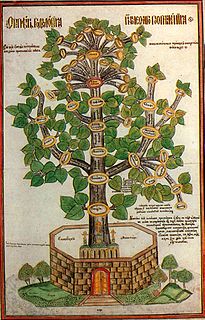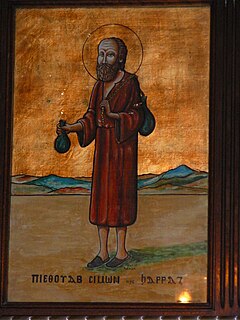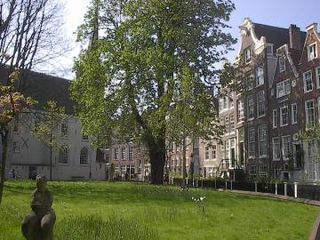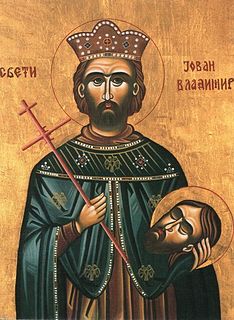
Cosmas Damian Asam was a German painter and architect during the late Baroque period. Born in Benediktbeuern, he lived in Rome from 1711-13 to study at the Accademia di San Luca with Carlo Maratta. In 1713 Asam won the Academy's first prize for his drawing of Miracle of Saint Pio. In Germany, he worked with his brother Egid Quirin, a sculptor and stucco worker, on building and decorating entirely new churches or redesigning churches in the Baroque style. Their joint projects are often attributed to the "Asam Brothers". Cosmas Damian died in Munich.

A church bell in the Christian tradition is a bell which is rung in a church for a variety of ceremonial purposes, and can be heard outside the building. Traditionally they were used to call worshippers to the church for a communal service, and to announce times of daily prayer, called the canonical hours. They are also rung on special occasions such as a wedding, or a funeral service. In some religious traditions they are used within the liturgy of the church service to signify to people that a particular part of the service has been reached. The ringing of church bells, in the Christian tradition, was also believed to drive out demons.

Hegumen, hegumenos, or igumen is the title for the head of a monastery in the Eastern Orthodox and Eastern Catholic Churches, similar to the title of abbot. The head of a convent of nuns is called a hegumenia or ihumenia. The term means "the one who is in charge", "the leader" in Greek.

John of Beverley was an English bishop active in the kingdom of Northumbria. He was the bishop of Hexham and then the bishop of York which was the most important religious designation in the area. He went on to found the town of Beverley by building the first structure there, a monastery. John was associated with miracles during and after his lifetime, and was canonised a saint by the Catholic Church in 1037.

A procession is an organized body of people walking in a formal or ceremonial manner.

Simon the Tanner, also known as Saint Simon the Shoemaker is the Coptic Orthodox saint associated with the story of the moving the Mokattam Mountain in Cairo, Egypt, during the rule of the Muslim Fatimid Caliph al-Muizz Lideenillah (953–975) while Abraham the Syrian was the Pope of the Coptic Orthodox Church of Alexandria.

The raising of the son of the widow of Nain is an account of a miracle by Jesus, recorded in the Gospel of Luke. Jesus arrived at the village of Nain during the burial ceremony of the son of a widow, and raised the young man from the dead.

The Paschal troparion or Christos anesti is the characteristic hymn for the celebration of the Orthodox Pascha (Easter) in the Eastern Orthodox Church and churches that follow the Byzantine Rite.
Venerable Macarius of the Yellow Water Lake and the Unzha, the Miracle Worker (1349–1444) is a Russian Orthodox saint. He is credited with the founding of four monasteries in the Middle and Upper Volga regions of Russia.

Glasney College was founded in 1265 at Penryn, Cornwall, England, by Bishop Bronescombe and was a centre of ecclesiastical power in medieval Cornwall and probably the best known and most important of Cornwall's religious institutions.

A processional cross is a crucifix or cross which is carried in Christian processions. Such crosses have a long history: the Gregorian mission of Saint Augustine of Canterbury to England carried one before them "like a standard", according to Bede. Other sources suggest that all churches were expected to possess one. They became detachable from their staffs, so that the earliest altar crosses were processional crosses placed on a stand at the end of the procession. In large churches the "crux gemmata", or richly jewelled cross in precious metal, was the preferred style. Notable early examples include the Cross of Justin II, Cross of Lothair, and Cross of Cong.

The Lity or Litiyá is a festive religious procession, followed by intercessions, which augments great vespers in the Eastern Orthodox and Byzantine Catholic churches on important feast days. Following a lity is another liturgical action, an artoklasia, and either of these terms may be used to describe both liturgical actions collectively.

The Begijnhof Chapel, dedicated to Saint John and Saint Ursula, is a Roman Catholic chapel run by the Congregation of the Blessed Sacrament, in the St Nicholas Parish of Amsterdam. It is located in a former schuilkerk in the Begijnhof across from its original location, the English Reformed Church, Amsterdam. The Miracle of Amsterdam is commemorated yearly with a procession starting from this church.

Bois-Seigneur-Isaac Abbey, in Ophain-Bois-Seigneur-Isaac, Belgium, is a former Augustinian abbey, now a Premonstratensian priory, dependent on Averbode Abbey.
Nazarena of Jesus, O.S.B. Cam., was an American Roman Catholic Camaldolese nun, who spent most of her adult life in a monastery as an anchoress, or recluse.
The North Monastery, commonly known as The Mon, is an education campus comprising Scoil Mhuire Fatima Primary School, North Monastery Secondary School and Gaelcholáiste Mhuire AG located at Our Lady's Mount, Cork, Ireland.

Jovan Vladimir or John Vladimir was the ruler of Duklja, the most powerful Serbian principality of the time, from around 1000 to 1016. He ruled during the protracted war between the Byzantine Empire and the First Bulgarian Empire. Vladimir was acknowledged as a pious, just, and peaceful ruler. He is recognized as a martyr and saint, with his feast day being celebrated on 22 May.

The Cult of the Lord Holy Christ of the Miracles, popularly known as Senhor Santo Cristo or Santo Cristo dos Milagres is a religious veneration associated with an image of Jesus Christ, depicted in the events of the New Testament. The wooden image of Christ, by unknown artist, in a Renaissance-style representation of the Ecce Homo, represents the episode of Jesus of Nazareth's life when the martyred religious figure was presented to the crowd following his whipping, and includes a crown of thorns, uncovered torso and bruised/beaten body. Narrated in the New Testament, the artist represented in grande artistic style the contrast between violence on the body and the serenity of the expression, emphasized by the gaze from the image.

The Ermita de San Nicolas de Tolentino is a chapel located along J.P. Rizal Avenue Extension in Barangay West Rembo, Makati, Philippines.



















